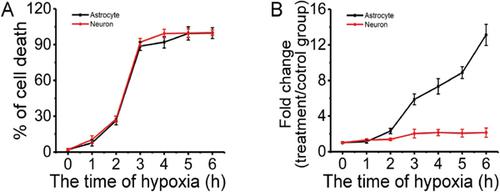Current Pharmaceutical Biotechnology ( IF 2.2 ) Pub Date : 2020-07-31 , DOI: 10.2174/1389201021666200210102425 Zhaohu Yuan 1 , Zhiwu Yu 2 , Yiyu Zhang 1 , Huikuan Yang 1

|
Background: Glial Maturation Factor Beta (GMFB) is a highly conserved brain-enriched protein implicated in immunoregulation, neuroplasticity and apoptosis, processes central to neural injury and repair following cerebral ischaemia. Therefore, we examined if changes in neurocellular GMFB expression and release can be used to assess brain injury following ischaemia.
Methods and Results: Immunofluorescence staining, Western blotting, immunohistochemistry and ELISA were used to measure GMFB in cultured neurons and astrocytes, rat brain tissues and plasma samples from stroke model rats and stroke patients, while cell viability assays, TTC staining and micro- PET were used to assess neural cell death and infarct severity. Immunofluorescence and immunohistochemistry revealed GMFB expression mainly in astrocyte and neuronal nuclei but also in neuronal axons and dendrites. Free GMFB concentration increased progressively in the culture medium during hypoxia-hypoglycaemia treatment. Plasma GMFB concentration increased in rats subjected to middle cerebral artery occlusion (MCAO, a model of stroke-reperfusion) and in stroke patients. Plasma GMFB in MCAO model rats was strongly correlated with infarct size (R2=0.9582). Plasma GMFB concentration was also markedly elevated in stroke patients within 24 h of onset and remained elevated for more than one week. Conversely, plasma GMFB elevations were not significant in myocardial infarct patients and stroke patients without infarction.
Conclusion: GMFB has the prerequisite stability, expression specificity and response dynamics to serve as a reliable indicator of ischaemic injury in animal models and stroke patients. Plasma GMFB may be a convenient non-invasive adjunct to neuroimaging for stroke diagnosis and prognosis.
中文翻译:

GMFB在脑梗死中的临床诊断价值分析。
背景:神经胶质成熟因子Beta(GMFB)是高度保守的大脑富集蛋白,与免疫调节,神经可塑性和细胞凋亡,对脑缺血后神经损伤和修复至关重要的过程有关。因此,我们检查了神经细胞GMFB表达和释放的变化是否可用于评估缺血后的脑损伤。
方法和结果:采用免疫荧光染色,蛋白质印迹,免疫组织化学和ELISA法检测中风模型大鼠和中风患者培养的神经元和星形胶质细胞,大鼠脑组织和血浆样品中的GMFB,同时进行细胞活力测定,TTC染色和micro-PET用于评估神经细胞死亡和梗塞严重程度。免疫荧光和免疫组化显示GMFB主要在星形胶质细胞和神经元核中表达,而且在神经元轴突和树突中也表达。在低氧低血糖症治疗期间,培养基中的游离GMFB浓度逐渐增加。患有大脑中动脉闭塞的大鼠(中风-再灌注模型)和中风患者的血浆GMFB浓度增加。MCAO模型大鼠血浆GMFB与梗死面积密切相关(R2 = 0.9582)。卒中患者在发病后24小时内血浆GMFB浓度也显着升高,并持续升高超过一周。相反,心肌梗塞患者和无梗塞的中风患者血浆GMFB升高不明显。
结论:GMFB具有必要的稳定性,表达特异性和反应动力学,可作为动物模型和中风患者缺血性损伤的可靠指标。血浆GMFB可能是神经影像学中风诊断和预后的一种方便的非侵入性辅助手段。











































 京公网安备 11010802027423号
京公网安备 11010802027423号